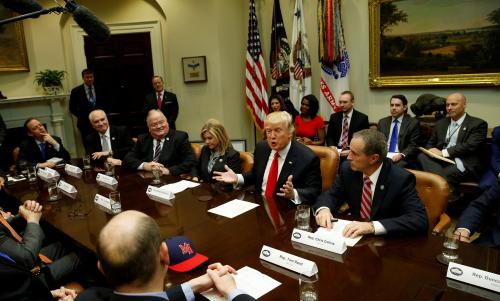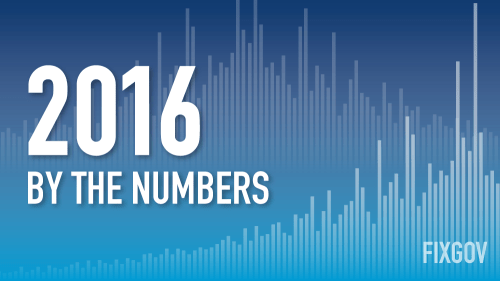You would think that after voting more than sixty times to repeal or roll back parts of Obamacare, it would finally happen now that Republicans control both chambers of Congress and the White House. But this week, the Republicans had real trouble getting enough votes, despite having campaigned on this for the past three election cycles, and in spite of the fact that President Trump made this a make or break vote. Ultimately, they could not muster the votes to pass the American Health Care Act (AHCA), leaving the Affordable Care Act in place and the future of the Republican leadership uncertain.
Why did they fail?
With the help of data generated by Brookings, the Cook Political Report, and the Center for American Progress, we put together the following table. It lists all thirty-two members of Congress who, as of Friday morning (the day the vote was supposed to take place), were listed by the Washington Post as voting against the AHCA.
The first data column lists the margin by which the incumbent congressperson won his or her last election. The average margin for these Republicans was 24 percent and the median was 22 percent. Only four of the probable no votes won with less than 10 percent of the vote and three won with more than 40 percent of the vote. (Two were unopposed.) By and large, these members come from very solidly Republican districts. They are not afraid of losing to a Democrat in a general election, but they could lose to an ideologically hard-right Republican challenger in a primary. Hence their hard-line position on the health care bill.
The second column is data taken from one of the most respected and utilized measures in American politics, the Cook Partisan Voting Index—the PVI for short. This is a measure that uses past voting behavior to analyze how Democratic or how Republican a congressional district is compared to the nation as a whole. Among the potential no votes, only one member’s district has a Democratic tilt. And only five districts have a Republican edge under five. The PVI reinforces the fact that these are safe Republican districts where the only threat to a member’s re-election is a primary threat.
The third column lists the margin of the presidential vote in each of these members’ districts that went to Donald Trump. Hillary Clinton only won three out of the 32 listed. In four others Donald Trump won by less than five percent. But in most of these districts, Trump won by large margins. The average Trump victory was 18 percent and the median was around 13 percent. In spite of his troubles across the country, Trump is still holding on to popularity in the Republican base. Because Trump captured the nomination from the top, not from the grass roots, he does not have the kind of organization that could mount primary challenges. Clearly few of these members feared the wrath of their president come primary time. More likely, they feared the Koch brothers who threatened to defeat anyone who voted against the president’s bill.
The fourth and fifth columns are taken from work done by David Cutler and Emily Gee for the Center for American Progress (CAP). Taking the Congressional Budget Office score of anticipated losses in health care coverage under the Republican bill, they combined census data, data from the Kaiser Family Foundation, and data from the Centers for Medicare and Medicaid Services to come up with estimates showing how many people in each congressional district would lose health care coverage under the Republican bill. The “CAP Losses” shows estimated losses in absolute numbers and the “CAP Rank” column shows where the congressional district ranks compared to all the other districts in the country.
Since there are 435 districts, those who are ranked below 217 will suffer higher losses in health insurance coverage than those ranked above 217. Among those inclined to vote no the potential losses were split somewhat evenly. There are 17 congressional districts in the bottom half of coverage losses and 20 districts in the top half of losses in coverage. One would expect that the fewer in their district who would lose insurance, the more likely the member of Congress would feel comfortable in holding to an ideologically pure position.
The final column is drawn from our research for The Primaries Project 2016, showing the candidate’s position on the Affordable Care Act during the 2016 election. The majority of the wavering candidates—23 of the 32—were explicitly opposed to Obamacare during their 2016 primaries. As our research on congressional primaries shows, Republican congressional candidates campaigned mostly on tax cuts and repeal of Obamacare. This also reinforces the conclusion that these wavering Republicans are concerned about “getting primaried” because they supported a bill that does not (in their eyes) repeal Obamacare.
President Trump is not the first president to find out how hard it is to pass legislation when a determined faction of your party is opposed to it. And he certainly won’t be the last. But he will likely be the first to unleash a Twitter storm. Stay tuned.
Republicans Members of Congress Opposing the AHCA
| Incumbent | District | 2016 Margin | PVI | Trump Margin | CAP Value | CAP Rank | Primaries position on ACA | |
|---|---|---|---|---|---|---|---|---|
| Ileana Ros-Lehtinen | FL-27 | 9.80% | D+9 | -19.7 | 81300 | 25 | Oppose | |
| Leonard Lance | NJ-7 | 11% | R+ 1 | -1.1 | 35200 | 421 | Oppose | |
| Rod Blum | IA-1 | 7.70% | R+ 3 | 3.5 | 41100 | 351 | Oppose | |
| David Young | IA-3 | 13.70% | R+ 3 | 3.5 | 45400 | 286 | Oppose | |
| Frank LoBiondo | NJ-2 | 22% | R+ 4 | 4.6 | 43900 | 307 | None | |
| Dave Brat | VA-7 | 15.30% | R+ 5 | 6.5 | 49700 | 241 | Oppose | |
| Charles W. Dent | PA-15 | 20.40% | R+ 5 | 7.6 | 42200 | 332 | Oppose | |
| Jaime Herrera Beutler | WA-3 | 23.50% | R+ 5 | 7.4 | 42600 | 325 | None | |
| Daniel Donovan | NY-11 | 24.90% | R+ 6 | 9.8 | 82100 | 23 | Oppose | |
| Brian Fitzpatrick | PA-8 | 9% | R+1 | 0.2 | 37800 | 398 | None | |
| Andy Biggs | AZ-5 | 28.20% | R+12 | -2.1 | 40700 | 81 | Oppose | |
| Bill Posey | FL-8 | 30.60% | R+12 | 20.7 | 57900 | 166 | Oppose | |
| Scott Perry | PA-4 | 32.10% | R+12 | 21.5 | 42500 | 327 | Oppose | |
| Walter B. Jones | NC-3 | 34.40% | R+13 | 23.6 | 70400 | 66 | Oppose | |
| Jody Hice | GA-10 | U | R+14 | 25.5 | 61500 | 139 | Oppose | |
| Mark Meadows | NC-11 | 28.20% | R+16 | 29.4 | 76900 | 40 | Oppose | |
| Mo Brooks | AL-5 | 33.50% | R+18 | 33.6 | 61400 | 141 | None | |
| Jim Jordan | OH-4 | 6% | R+19 | 33.6 | 39900 | 364 | None | |
| Warren Davidson | OH-8 | 41.80% | R+19 | 34.5 | 39500 | 372 | Oppose | |
| Eric A. “Rick” Crawford | AK-1 | U | R+19 | 34.8 | 51000 | 224 | None | |
| Thomas Massie | KY-4 | 42.60% | R+20 | 35.9 | 42700 | 324 | Oppose | |
| Raúl R. Labrador | ID-1 | 36.40% | R+23 | 38.3 | 67400 | 83 | Oppose | |
| Louie Gohmert | TX-1 | 49.80% | R+25 | 46.9 | 63700 | 112 | Oppose | |
| Ted Budd | NC-13 | 12.20% | R+6 | 9.4 | 77300 | 38 | Oppose | |
| Justin Amash | MI-3 | 22% | R+6 | 9.4 | 43600 | 314 | None | |
| Thomas Garrett | VA-5 | 16.60% | R+7 | 11.1 | 55700 | 182 | Oppose | |
| Mark Amodei | NV-2 | 21.40% | R+8 | 12.3 | 37500 | 407 | None | |
| Mark Sanford | SC-1 | 21.80% | R+8 | 13.1 | 56600 | 175 | Oppose | |
| Rob Wittman | VA-1 | 23.30% | R+8 | 12.4 | 45600 | 282 | Oppose | |
| Don Young | AK-1 | 14.30% | R+9 | 15.2 | 44500 | 295 | Oppose | |
| Ted Yoho | FL-3 | 16.80% | R+9 | 16 | 64200 | 106 | Oppose | |
| Chris Smith | NJ-4 | 30.20% | R+9 | 14.8 | 39100 | 380 | None | |
| Sources: Brookings, Cook Political Report, Center for American Progress | ||||||||







Commentary
Why did the GOP have such a hard time repealing and replacing Obamacare?
March 24, 2017